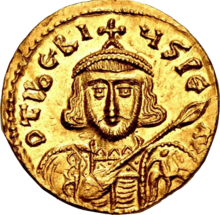
Back Tiberius III Apsimar Afrikaans Tiberio III AN تيبريوس الثالث Arabic تيبريوس التالت ARZ Tiberiu III AST III Tiberi (imperator) Azerbaijani اۆچونجو تیبریوس AZB Тыверый III Byelorussian Тиберий III Апсимар Bulgarian Tiberius III Breton
| Tiberius III | |||||
|---|---|---|---|---|---|
| Emperor of the Romans | |||||
 Solidus bearing the image of Tiberius III | |||||
| Byzantine emperor | |||||
| Reign | 698–705 | ||||
| Predecessor | Leontius | ||||
| Successor | Justinian II | ||||
| Born | Apsimar | ||||
| Died | between August 705 and February 706 Constantinople | ||||
| Burial | Prote | ||||
| Issue |
| ||||
| |||||
| Period | Twenty Years' Anarchy | ||||
Tiberius III[b] (Greek: Τιβέριος, romanized: Tibérios), born Apsimar (Latin: Apsimarus; Greek: Ἀψίμαρος, romanized: Apsímaros), was Byzantine emperor from 698 to 705. Little is known about his early life, other than that he was a droungarios, a mid-level commander, who served in the Cibyrrhaeot Theme. In 696, Tiberius was part of an army sent by Byzantine Emperor Leontius to retake the North African city of Carthage, which had been captured by the Arab Umayyads. After seizing the city, this army was pushed back by Umayyad reinforcements and retreated to the island of Crete. As they feared the wrath of Leontius, some officers killed their commander, John the Patrician, and declared Tiberius the emperor. Tiberius swiftly gathered a fleet and sailed for Constantinople, where he then deposed Leontius. Tiberius did not attempt to retake Byzantine Africa from the Umayyads, but campaigned against them along the eastern border with some success. In 705, former emperor Justinian II, who had been deposed by Leontius, led an army of Slavs and Bulgars from the First Bulgarian Empire to Constantinople, and after entering the city secretly, deposed Tiberius. Tiberius fled to Bithynia, but was captured a few months later and beheaded by Justinian between August 705 and February 706. His body was initially thrown into the sea, but was later recovered and buried in a church on the island of Prote.
Cite error: There are <ref group=lower-alpha> tags or {{efn}} templates on this page, but the references will not show without a {{reflist|group=lower-alpha}} template or {{notelist}} template (see the help page).